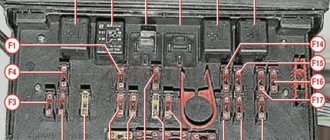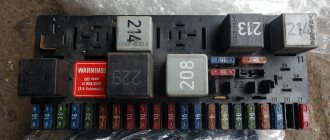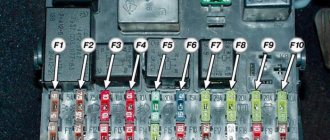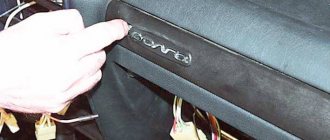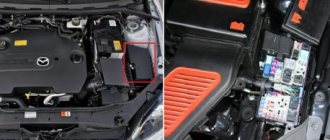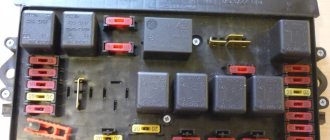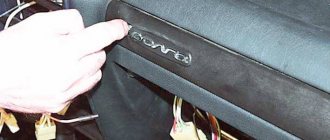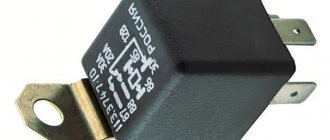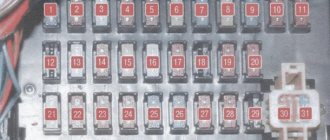Hyundai Accent fuse box: what each element is responsible for
This brand of car has numbered markings of safety elements, which are located in a clear sequence - the functional purpose of the fuse in each block is easily identified from the following list:
No. Passing power, A Functional purpose
| 1 | 10 | The element is responsible for the turning system, as well as duplicating turns and electrically adjustable side-view mirrors if these functions are included in the vehicle configuration |
| 2 | 10 | A technical fuse that regulates the operation of the anti-lock braking system sensors and instrument panel indicators. As a rule, if this part comes out, the car will not be able to start - this is done for safety reasons. |
| 3 | 10 | The element is responsible for the operation of the instrument cluster circuit |
| 4 | 15 | 15-amp fuses are designed to prevent short circuits on the sensors and squibs of all airbags present in the vehicle interior |
| 5 | 10 | A technical element responsible for the operability of the engine electronic control unit systems, as well as the automatic transmission control unit if it is included in the configuration |
| 6 | 10 | The fuse is responsible for the operation of the door position sensors and the central locking remote control system |
| 7 | 10 | This element in the system is responsible only for the operation of the alarm and braking signals |
| 8 | 10 | Protecting the headlight relay coils, power windows, climate control or air conditioning compressor, as well as fog lights and tail lights against short circuits |
| 9 | 20 | The element protects headlight or windshield wipers, as well as wipers and heated windshields from voltage surges |
| 10 | 10 | Reserve socket, which is used when connecting new equipment in a car or to reduce the current load on other fuses |
| 11 | 20 | An element responsible for protecting the cigarette lighter in a car from burnout or short circuit. As a rule, failure occurs several times per season due to the cigarette lighter being overloaded with various gadgets |
| 12 | 10 | Air conditioning circuit fuse. Used if block element No. 8 is already overloaded with other equipment |
| 13 | 10 | Used for separate protection of multimedia equipment - audio systems, all-round cameras or multimedia console |
| 14 | 10 | Auxiliary fuse for the heated seat option. If this function is not included in the configuration, the car is a backup |
| 15 | 10-20 | Reserve socket, which is used when connecting new equipment in a car or to reduce the current load on other fuses |
Important to remember! If any of the car’s functions does not work, before disassembling the vehicle’s equipment, it is important to check the integrity of all fuses in the blocks - as a rule, these elements regularly fail when saving on a high-quality battery or as a result of “handicraft” tuning and connecting a lot of additional gadgets.
Location and electrical diagram
Hyundai accent
If you notice that any device or part of electrical equipment has begun to work incorrectly or has completely broken down, there is no need to rush to replace the broken element. First you need to check the condition of the PP. Sometimes the reason for non-working headlights, stove, or fuel pump lies precisely in the failure of the PP.
Loading …
Like any vehicle, the Hyundai Accent is equipped with fuse blocks. Moreover, in the case of this car model there are three of them. Two of them are located inside the car, and one more is in the engine compartment. We invite you to familiarize yourself with the diagram and purpose of each power supply. Also remember that the diagram and purpose of the elements is applied to the inside of the plastic cover that protects the power supply.
PSU in the cabin
As mentioned earlier, there are several power supplies located inside the car. One of them is located on the driver's side, in the area of the left leg. To get to it, you need to remove the plastic decorative trim that is located on the dashboard.
Diagram of the power supply located in the Hyundai Accent interior
Below we invite you to familiarize yourself with the purpose of each component of the device.
Description of the purpose of the parts of the power supply unit, which is located in the driver’s seat area in the Hyundai Accent cabin
The second device is located behind the additional glove compartment in the cabin. To be more precise, relays are installed there, not fuses. They are designed to protect more powerful energy consumers.
Diagram of the assignment of elements of the device, which is located in the car interior
| Detail number | Its purpose |
| 1 | This relay ensures the functioning of the electronic device responsible for the distribution of braking forces. If it breaks down, the vehicle may not brake correctly (during emergency braking, the car may pull to the side). |
| 2 | Responsible for the operation of the rear fog lamps. |
| 3 | This relay is the main one in the Hyundai Accent engine control system. In the photo it is disconnected from its connector. |
| 4 | Responsible for the operation of headlights. If it breaks down, both the low and high beams, as well as the dimensions, may not work. |
| 5 | The device ensures the operation of the cleaner motor, as well as. |
| 6 | A part responsible for the performance of the ABS system. |
| 7 | Provides the functionality of power windows. |
| 8 | This device is responsible for the operation of the rear window heating mechanism. |
| 9 | Provides operation of the steering horn. |
| 10 | Responsible for the operation of direction indicator lamps, as well as light signaling. |
As you can see, most of the vehicle's electrical components that require voltage to operate are protected by fuses and relays.
Where are the Hyundai Accent fuses located?
Replacing damaged elements in the safety block will not be difficult - the whole procedure is simple and follows an intuitive script. The greatest difficulties for drivers arise when searching for a damaged element - 2 or 3 units can be installed on different generations of Hyundai Accent.
Depending on the model, there may be 1 or 2 blocks in the car interior; a separate block will be located in the engine compartment:
- The first interior unit is located near the driver's seat on the left side - to ensure easy access you will have to remove the decorative trim in the car's dashboard;
- The second fuse box will be located behind the additional glove compartment in the cabin. In some versions of the Hyundai Accent there will be only a few relays located there, in others there will be a relay and several fuse cells;
- Under the hood the block is located on the left side of the engine. All fuses under the hood are located in a sealed box, which is secured with plastic latches - when dismantling it is important not to damage the fastenings, otherwise moisture will quickly enter the system, which will lead to corrosion of the block itself and oxidation of the chips.
To make it easier to find a faulty element, you need to remember that in the engine compartment there will be fuses responsible for the main wiring, engine and electrical equipment of the car, and in the passenger compartment there will be protective elements for additional equipment and equipment options.
Problems when paying with bank cards
Technical characteristics of Hyundai Accent 2
Sometimes difficulties may arise when paying with Visa/MasterCard bank cards. The most common of them:
- There is a restriction on the card for paying for online purchases
- A plastic card is not intended for making payments online.
- The plastic card is not activated for making payments online.
- There are not enough funds on the plastic card.
In order to solve these problems, you need to call or write to the technical support of the bank where you are served. Bank specialists will help you resolve them and make payments.
That's basically it. The entire process of paying for a book in PDF format on car repair on our website takes 1-2 minutes.
If you still have any questions, you can ask them using the feedback form, or write us an email at [email protected]
Fuses and relays HUNDAI ACCENT
Relay and fuse mounting block in the engine compartment
1 - fuse 100 A generator circuit; 2 - 50 A complex fuse (electric circuits for door lock, alarm, brake signals, heated rear window, sound signal, interior lamp, ECU); 3 - 30 A fuse for the head and side light lamp circuit; 4 - 20 A fuse for the engine control unit circuit; 5 - 30 A fuse for the engine starting circuit and ignition coils. 6 - 20 Amp fuse for the radiator fan circuit of the engine cooling system, 7 - electrical wiring connector, 8 - heater fan relay. 9 - horn relay, 10 - 10 A fuse for the Hyundai Accent interior lamp circuit. 11 - 10 A fuse for the head unit circuit of the sound reproduction system. 12 — relay 2 of the air conditioning condenser heat exchanger fan, 13 — air conditioning compressor clutch relay, 14 — fog lamp relay socket; 15 — reserve fuse socket; 16 - 15 A fuse for idle speed control and camshaft position sensor. 17 - 10 A fuse of the engine control unit circuit. 18 — radiator fan relay for the engine cooling system; 19 - 10 A fuse for the air conditioner switching circuit; 20 — relay 1 of the condenser heat exchanger fan of the air conditioning system; 21 - 10 A fuse of the engine control unit circuit, 22 - 10 A fuse of the air conditioning compressor clutch circuit, 23 - 10 A fuse of the horn circuit; 24 - 15 A fuse for the fog lamp circuit. 25 - 10 A fuse for the right headlight lamp circuit. 26 - 10 A fuse for the left headlight lamp circuit; 27 - 10 A fuse for the side light lamp circuit on the right side of the car; 28 - 10 A fuse for the side light lamp circuit on the left side of the car; 29 — side light lamp relay; 30 — generator pre-excitation resistor; 31 — Hyundai Accent starter relay, 32 — 20 A fuse for the condenser heat exchanger fan circuit, 33 — 30 A fuse for the electric window circuit. 34 - 30 A fuse of the ABS control unit circuit; 35 — relay socket for always-on low beam; 36 — fuel pump relay; 37 - 30 A fuse of the ABS control unit circuit; 38.39 - diode socket; 40 - 30 Amp fuse for the heater fan circuit.
Mounting block under the hood Accent
Description of the electrical circuit of the engine compartment “black box” of this Hyundai Accent model:
| Element marking | Decoding |
| Generator | |
| Hazard warning light, horn, heated rear window, interior lighting | |
| Main lighting | |
| Ignition coil | |
| Radiator fan | |
| Heating fan | |
| Sound signal | |
| Interior lighting | |
| Audio system and radio | |
| Heat exchanger | |
| Air conditioner | |
| Fog lights | |
| Idling | |
| Radiator fan | |
| Air conditioner | |
| Temperature exchanger | |
| Engine | |
| Heat exchanger and air conditioner | |
| Klaxon | |
| Fog lamps | |
| Head light on the right | |
| Head light left | |
| Dimensions front and rear on the right side | |
| Dimensions front and rear left | |
| parking lights | |
| Generator | |
| Heat exchanger and air conditioner | |
| Electric windows | |
| ABS system | |
| Low beam | |
| Fuel pump | |
| ABS system | |
| Diode socket | |
| Diode socket | |
| Heating fan |
Fuse box in the engine compartment
The mounting block is located on the left side, between the air filter housing, battery and body. To repair your car yourself, you need to be able to read electrical diagrams. Fuses are used to protect circuits from short circuits. List of fuses located in the engine compartment:
- F1 – generator circuit protection (rated 100 A). When this fuse fails, the battery begins to discharge faster. If there is no charge at the battery terminals, it is necessary to check the belt tension, the contacts on the generator, the condition of the brush assembly and the voltage regulator.
- F2 – protection of the door lock circuit. The fuse rating is 50 Amps. It also protects the power supply circuits for the alarm system, horn, heating element on the rear window, microcontroller engine control unit, interior lighting, and various electric drives (including mirrors). Therefore, if the brake light, sensors on the Hyundai Accent do not work, the car does not start, the first thing you check is this fuse. If the alarm system fails, you need to check fuses No. 1 and No. 7 located in the cabin block. If they are working properly, then you need to diagnose relay No. 10. The last thing to diagnose is the button and wiring.
- F3 (30 Amperes) – designed to protect the power supply circuits of the head light and side lights. In the event of a lighting failure, it is necessary to check fuses No. 27 and 28, as well as relay No. 4, which are located in the passenger compartment.
- F4 - this fuse supplies power to the motor control unit. Rated current 20 A. If the engine cannot be started, you need to check this fuse. Only after F5, F6, F16, F17, F18, F21 and in the cabin F5 and electromagnetic relay 3.
- Through F5 (30 Amperes) power is supplied to the ignition coils.
- Through F6 (20 A) and F18, power is supplied to the radiator fan electric motor.
- F10 (10A) – power supply for interior lighting circuits.
- F11 (10A) – protection of the car radio power circuit.
- F16 protects the power supply circuits of the DPRV (phase sensor) and IAC (idle air regulator). Rated current 15A.
- F17 – power is supplied to the ECU through it. View information on F
- F19 (rated 10A) – power supply to the air conditioner control circuits.
- F21, F22, F23 (all rated 10A) - protection of ECU circuits, air conditioning compressor clutch, sound signal, respectively.
- F24 – fog lights.
- F25 and F26 (10A) – head lighting on the left and right sides, respectively.
- F27 and F28 (10A) – side lighting lamps on the right and left sides, respectively.
- F32 – protection of the air conditioner condenser heat exchanger fan circuit.
- F33 – power supply circuit for electric windows.
- F34 and F37 – ABS control unit (if equipped).
- Heating fan – F
Maintenance regulations emphasis
LOCATION OF THE MAIN UNITS OF THE Hyundai Accent CAR (Hyundai Accent)
Engine compartment of the car: 1 — expansion tank of the engine cooling system; 2 — power steering reservoir; 3 — oil filler cap; 4 - engine; 5 — vacuum brake booster; 6 — reservoir of the main brake cylinder; 7 — hydraulic clutch reservoir; 8 — air filter housing; 9 — relay and fuse block; 10 - battery; 11 — radiator cap; 12 — oil level indicator (dipstick); 13 — windshield washer reservoir
MAINTENANCE INTERVIEW
The maintenance intervals shown in the table on p. 28, correspond to the minimum permissible maintenance frequency recommended by the manufacturer. During the operation of the vehicle,
there is a change in its technical condition due to wear of the working surfaces of parts, violation of regulatory parameters, aging of plastic and rubber products. To keep your vehicle in good working order, you may need to perform some of the procedures described more frequently.
If the car is operated in conditions of great dust, low ambient temperature,
environment, used for transporting a trailer, frequent trips at low speeds or short distances - then maintenance must be carried out at shorter intervals. During the operation of the vehicle, it is necessary to regularly carry out visual inspections in order to detect possible malfunctions at an early stage, even before they lead to the need for expensive repairs.
The front of the car (bottom view): 1 - front wheel brake mechanism; 2 — front suspension arm; 3 — front wheel drive; 4 - engine; 5 - catalytic manifold; 6 — intermediate pipe of the exhaust gas system; 7 — gearbox; 8 — subframe; 9 — anti-roll bar; 10 — steering rod; 11 — hydraulic pipes of the brake system; 12 — fuel vapor recovery system tube; 13 — fuel pipe; 14 - additional muffler for the exhaust gas system
Rear part of the car (bottom view): 1 - main muffler of the exhaust gas system; 2 — wishbones; 3 — trailing arm; 4 — anti-roll bar; 5 — additional muffler for the exhaust gas system; b - fuel tank; 7 — adsorber of the fuel vapor recovery system; 8 — niche for spare wheel
| MAINTENANCE REGULATIONS | |||||||||||||
| Serviced object | Mileage, km (x1000) | ||||||||||||
| 2 | 10 | 20 | 30 | 40 | 50 | 60 | 70 | 80 | 90 | 100 | 110 | 120 | |
| Drive belts | P | P | P | P | P | P | 3 | P | P | P | P | P | P |
| auxiliary units | |||||||||||||
| High voltage wires | — | P | — | — | P | — | — | P | — | — | P | — | P |
| Hoses and pipes | P | P | P | P | P | P | P | P | P | P | P | P | P |
| engine | |||||||||||||
| Timing belt | — | — | — | — | — | — | 3 | — | — | — | — | — | 3 |
| Spark plug | — | — | 3 | — | 3 | — | 3 | — | 3 | — | 3 | — | 3 |
| Coolant | P | P | P | P | 3 | P | P | P | 3 | P | P | P | 3 |
| Hydraulic fluid | P | P | P | P | 3 | P | P | P | 3 | P | P | P | 3 |
| brakes and clutch | |||||||||||||
| Air filter | P | P | P | 3 | P | P | 3 | P | P | 3 | P | P | 3 |
| battery | — | P | P | P | P | P | P | P | P | P | P | P | P |
| Fuel filter | — | — | — | — | 3 | — | — | — | 3 | — | — | — | 3 |
| Suspension parts (including boots), | P | P | P | P | P | P | P | P | P | P | P | P | P |
| mounting bolts | |||||||||||||
| CV boots | P | P | P | P | P | P | P | P | P | P | P | P | P |
| Steering joints and boots, | P | P | P | P | P | P | P | P | P | P | P | P | P |
| power steering fluid | |||||||||||||
| Manual transmission oil | P | P | P | P | P | P | P | P | P | 3 | P | P | P |
| Automatic transmission fluid | P | P | P | P | P | P | P | P | P | 3 | P | P | P |
| Engine oil | 3 | 3 | 3 | 3 | 3 | 3 | 3 | 3 | 3 | 3 | 3 | 3 | 3 |
| and oil filter | |||||||||||||
| Exhaust system | P | P | P | P | P | P | P | P | P | P | P | P | P |
| (tightness) | |||||||||||||
| Brake and clutch pedals | P | P | P | P | P | P | P | P | P | P | P | P | P |
| (free running) | |||||||||||||
| Parking lever | P | P | P | P | P | P | P | P | P | P | P | P | P |
| brakes | |||||||||||||
| Air filter | 3 | 3 | 3 | 3 | 3 | 3 | |||||||
| ventilation systems | |||||||||||||
| Wheels and tires, (tire pressure and wear, torque | P | P | P | P | P | P | P | P | P | P | P | P | P |
| wheel nut tightening) | |||||||||||||
| Hoses and tubes of the brake system | P | P | P | P | P | P | P | P | P | P | P | P | P |
| (tightness) | |||||||||||||
| Brake pads, | P | P | P | P | P | P | P | P | P | P | P | P | P |
| discs and drums | |||||||||||||
| Fuel system pipes | P | P | P | P | P | P | P | P | P | P | P | P | P |
| (tightness) | |||||||||||||
| Toxicity | P | P | P | P | P | P | P | P | P | P | P | P | P |
| exhaust gases | |||||||||||||
| Door locks, hinges, | P | P | P | P | P | P | P | P | P | P | P | P | P |
| clamps | |||||||||||||
| Cleaner and washer | P | P | P | P | P | P | P | P | P | P | P | P | P |
| windshield | |||||||||||||
| Lighting | P | P | P | P | P | P | P | P | P | P | P | P | P |
P - check, if necessary, cleaning, adjustment or replacement; 3 - replacement.
In severe operating conditions, these operations are performed every 5,000 km or 6 months.
Fuse box in the passenger compartment
The above information about fuses is quite enough to get rid of major breakdowns in electrical equipment. We must remember that the weakest link always fails. If you first install a 30A fuse, and then install it at 10A, in the event of a short circuit, the one with the lower operating current will fail. The second one will remain safe and sound. A block is placed under the hood that protects power circuits - several units at once. Fuses in the cabin
But in the cabin, fuses are installed to protect individual lamps and even devices. Table with characteristics and purpose of fuses:
| Fuse number | Rated operating current, A | What circuits does it protect? |
| F1 | 10 | Turn signals |
| F2 | 10 | ABS system and lamps on the car dashboard |
| F3 | 10 | Power supply for instruments on the dashboard |
| F4 | 15 | Airbags |
| F5 | 10 | ECU, reverse warning lamps, automatic transmission control (if equipped) |
| F6 | 10 | Central locking, door lock drives |
| F7 | 10 | Emergency crew |
| F8 | 10 | Stop signal |
| F9 | 20 | Heating element on the rear window |
| F10 | 10 | Electric windows, headlight washers, radiator and heat exchanger fans, headlight relay coils, fog lights |
| F11 | 20 | Windshield washer and wiper |
| F12 | 10 | Seat heating element |
| F13 | 10 | ABS |
| F14 | – | Reserve |
| F15 | 15 | Cigarette lighter |
| F16 | 10 | Electric mirror drive |
Maps and diagrams of Kislovodsk
Above is a detailed map of Kislovodsk with streets and house numbers. Use the menu on the left to mark the necessary objects on the map, for example, the sanatoriums of Kislovodsk. Zoom out on the map to see where Kislovodsk is located on the map of Russia. Switch to “Satellite” mode to see the satellite map of Kislovodsk. Below we have added a map of Kislovodsk park, a map of public transport routes and a road map. Yandex and Google maps of Kislovodsk are on the list of popular maps. Mobile applications with offline maps are available for download.
Popular cards
Interactive map of Kislovodsk with streets from Google Streets, objects, panoramas, hotels and much more
Interactive map of Kislovodsk with houses from Yandex Streets, traffic conditions, object search, photos and more
Detailed map of Kislovodsk from 2GIS Streets with house numbers, transport, objects and more
Interactive map of Kislovodsk from Wikimapia Street view, location search and much more
Interactive road map of Kislovodsk from ViaMichelin
Kislovodsk railway map from OpenRailwayMap
Schemes and maps of public transport
Map of public transport routes in Kislovodsk from Wikiroutes Buses, minibuses, trains, cable car
Map of Kislovodsk with transport stops from Here Transport nearby, route planning
Maps for smartphones (iOS, Android)
Wikiroutes for Android Find routes on a map
Wikiroutes for iOS Find routes on a map
2GIS for Andriod Directory, navigator, offline maps
2GIS for iOS Directory, navigator, offline maps
Yandex.Maps for Andriod Search for objects on an interactive map, navigator and much more
Yandex.Maps for iOS Search for objects on an interactive map, navigator and much more
Yandex.Transport for Andriod Public transport movement, stops, route planning
Yandex.Transport for iOS Public transport movement, stops, route planning
Other maps and diagrams
Map of Kislovodsk with sanatoriums from Bing
Map of Kislovodsk with attractions from Sygic Maps Restaurants, parks, sanatoriums, observation decks and much more
Download in JPG format
Precipitation map in Kislovodsk from Windy Air temperature, wind
Sights of Kislovodsk on the map from Lonely Planet Resort park, museums, galleries, fountains
Relay box in the cabin
Relay in the Hyundai Accent interior
The block with electromagnetic relays is located in the cabin, right behind the small glove box. Description and purpose (according to the picture):
- Activation of the EBD (brake force distribution) system.
- Turn on the rear fog lights.
- Main relay COURT.
- Head lighting.
- Windshield wiper and washer.
- ABS activation.
- Electric windows.
- Heated rear window.
- Klaxon.
- Turn signals and hazard lights.
For the Accent model, the electrical diagrams can be found in the manual. The article provides only diagrams of the location of fuses and electromagnetic relays located in the mounting blocks of the engine compartment and passenger compartment.
Decoding
Scheme with decoding.
F1 ( red 10 A) - Turn indicators F2 ( red 10 A) - ABS system, control and warning lamps in the instrument cluster F3 ( red 10 A) - Instrument cluster F4 ( blue 15 A) - Airbag F5 ( red 10 A) - engine control unit, automatic transmission (if equipped), reverse lamps F6 ( red 10 A) - Door lock drive F7 ( red 10 A) - Hazard alarm F8 ( red 10 A) - Brake light lamps F9 ( yellow 20 A ) — Rear window heating F10 ( red 10 A) — Relay coil for headlights, power windows, headlight washer, air conditioning heat exchanger fan, radiator fan F11 ( yellow 20 A) — Windshield cleaner and washer F12 ( red 10 A) — Heated rear seat F13 ( red 10 A) — ABS F14 ( blue 15 A) — Cigarette lighter and audio system F15 ( red 10 A) — Electric exterior mirrors F16 ( red 10 A) — Air conditioning system
The Koreans drew this diagram.
How to extract?
To remove fuses, there is a special tool in the block - tweezers. They need to pinch the edge of the fuse and pull it out. There are duplicate tweezers in the block under the hood.
Tweezers.
Cigarette lighter fuse
The fuse you need is located in the passenger compartment.
That's right, the fuse is numbered F14. But you got F13. Although logically he is just fourth from the top. And you should have lower. That is, fifth from the top in the right row.
You pulled out a red color (10 A), but you should have a blue color for 15 A.
The fuse is marked with an arrow.
Fuse and tweezers for removing it.
Even if the fuse looks intact, “for peace of mind” replace it with a working one (known to be good). Or call. To the right of the row there are places for backup fuses, you can take a good one from there.
Sources
- https://zapchasti.expert/predoxraniteli/predoxraniteli-hyundai-accent.html
- https://vsepredohraniteli.ru/hyundai/accent.html
- https://electroshemi.ru/publ/khundaj/khundaj_akcent/23-1-0-276
- https://rem-accent.ru/hendaj-aktsent-predohraniteli.html
- https://korean-car.ru/blok-predohranitelei-v-salone-na-hyundai-accent/
- https://korean-car.ru/predohranitel-prikurivatela-na-hyundai-accent/
How to replace fuses in a Hyundai Accent: step-by-step instructions
The procedure for replacing fuses in the block is simple - to remove a damaged element, you only need tweezers or a special puller; no other equipment is required. To replace fuses on a Hyundai Accent you need:
- Be sure to disconnect the battery, both terminals;
- Next, we find the burnt out element and carefully remove it;
- If necessary, you can use a rough brush to clean the contacts in the block from oxidation;
- Then we press the new part onto the connector in the block until we hear a characteristic click.
At the end of the procedure, connect the battery and start the car to test the system. If the fuse of the recommended power blows out immediately, then you may need to take the car to a service station to diagnose electrical equipment and wiring.
Removal and replacement procedure
There is nothing complicated in the process of changing software. Even a novice motorist can handle this. The only thing you need to know is the location of the PCB that needs to be replaced, as well as a few nuances. For example, all work on changing the PP must be carried out with the battery disconnected and the ignition turned off.
So, let's start replacing the PP.
First, decide what you need to replace. In accordance with the provided diagrams, you should understand which power supply unit needs to change the relay or fuse. Once you know which unit you need, open the hood. Even if you need to change the PP in a unit installed in the cabin, still open the hood and disconnect the battery. To do this, you do not need to completely remove it; it is enough to disconnect only the negative terminal. Before doing this, do not forget to turn off the ignition. Next, you need to open the cover of the mounting block. If you can't do this by hand, you can use a flat-head screwdriver. By doing this, you get access to all software. If you know exactly which part you need to replace, remove it using special tweezers or by hand. If you are not sure about the functionality of an element, you can check it visually. To do this, dismantle a certain fuse and just look at it: there is a fusible thread running inside the component. If it burns out or breaks, then the PP needs to be changed
Note! Under no circumstances should you install homemade fuses in the block in the form of a piece of wire or a regular paper clip. Such fraud may save you for a while, but the consequences can be catastrophic.
The photo shows the location of the power supply in the interior of a Hyundai Accent car. Depending on your need, find one of three mounting blocks.
Open the decorative cover of the power supply unit and find the burnt-out component. You can dismantle it using special tweezers or your fingers.
To understand that you need to replace this particular PCB, look at it: the fusible thread indicated by the arrow will be burnt out or torn if the fuse has failed. After replacing the PP, check the functionality of the required device. If the problem was in the PP, then the equipment will work. Replace the decorative trim and do not forget to connect the battery
Also pay attention to the fact that the rating of the replaced devices must be the same. That is, if the number 10 is marked on the PCB, then it is advisable to use 10-amp fuses at the installation location of this part
If it is not possible to replace the PCB with a part with the same rating, then, as an exception, you can temporarily operate a device with a higher or lower rating. But it will need to be replaced at the first opportunity.
